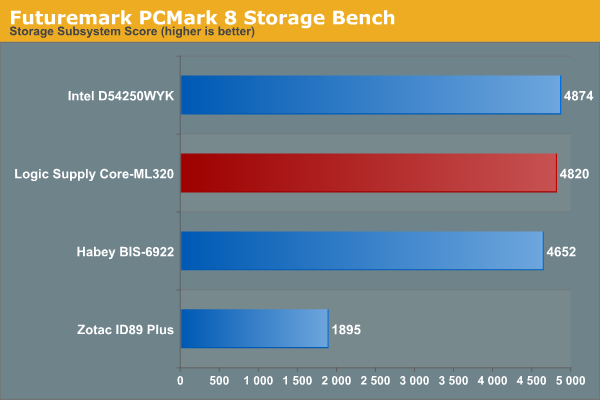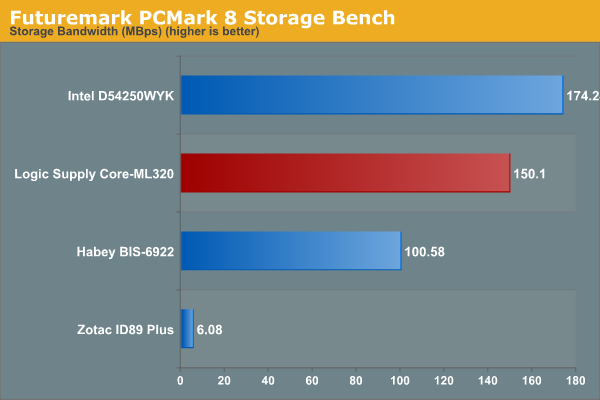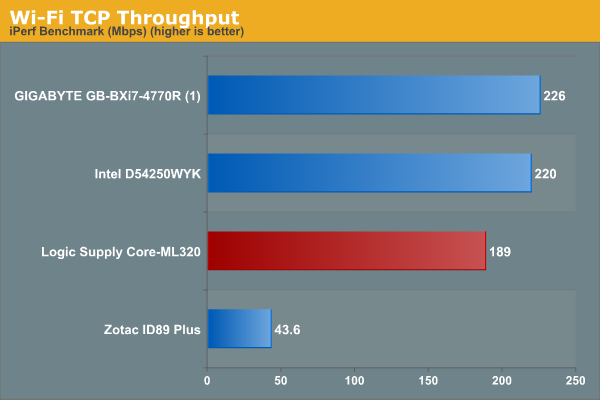Logic Supply Core-ML320 Fanless Industrial NUC Review
by Ganesh T S on April 30, 2014 3:45 PM EST- Posted in
- NUC
- Industrial PC
- Passive Cooling
- Logic Supply
Storage & Wireless Networking Credentials
Starting with this review, we have decided to devote a separate section to analyze the storage and networking credentials of the units under review. On the storage side, one option would be repetition of our strenuous SSD review tests on the drive(s) in the PC. Fortunately, to avoid that overkill, PCMark 8 has a storage bench where certain common workloads such as loading games and document processing are replayed on the target drive. Results are presented in two forms, one being a benchmark number and the other, a bandwidth figure. We ran the PCMark 8 storage bench on selected PCs and the results are presented below.
In using the PCMark 8 storage benchmark, our intent is to test the primary drive in the system. Our review sample of the Core-ML320 shipped with a 32 GB mSATA SSD as the primary drive. After the installation of the OS and adding in a couple of updates, we were down to less than 2 GB of free space on the drive. PCMark 8's storage bench, unfortunately, required more free space, and we ended up using the secondary drive (the 60 GB 2.5" SSD) for this test.


On the networking side, we restricted ourselves to the evaluation of the WLAN component. Our standard test router is the Netgear R7000 Nighthawk configured with both 2.4 GHz and 5 GHz networks.
Netgear R7000 Nighthawk Testbed Router
The router is placed approximately 20 ft. away, separated by a drywall (as in a typical US building). A wired client (Zotac ID89-Plus) is connected to the R7000 and serves as one endpoint for iPerf evaluation. The PC under test is made to connect to either the 5 GHz (preferred) or 2.4 GHz SSID and iPerf tests are conducted for both TCP and UDP transfers. It is ensured that the PC under test is the only wireless client for the Netgear R7000.
We evaluate total throughput for up to 32 simultaneous TCP connections using iPerf and present the highest number in the graph below.

In the UDP case, we try to transfer data at the highest rate possible for which we get less than 1% packet loss.

We find that the PCs equipped with 802.11ac WLAN cards perform better than the 802.11n ones. For the Core-ML320, the choice of a 2x2 dual band 802.11n card (Intel Centrino Advanced-N 6235) help in delivering very good numbers. In fact, the numbers are very close to the AC7260-equipped Intel NUC kit.











31 Comments
View All Comments
jcknows0 - Wednesday, April 30, 2014 - link
The chassis itself is a little on the pricey side. Its pretty hard to recommend a $1300 i5 system with less than 100 GB SSD space. I just built my latest NUC for under $300, just doesn't seem worth it for fanless.faiakes - Wednesday, April 30, 2014 - link
For Europeans, there is the very similar Alaska Tesla H. High-tech reviewed it and compared it to the Intel and another custom case herehttp://www.bit-tech.net/hardware/cases/2014/03/20/...WithoutWeakness - Wednesday, April 30, 2014 - link
The target market for these types of fanless, industrial, SFF machines is not the same target market as Intel's off-the-shelf NUC or Gigabyte's Brix. Fanless boxes like these are meant to be deployed in areas where the machine likely needs to be running 24/7/365 and any downtime is an order of magnitude more costly than the $1300 that the box costs. Overheating due to fan failures, untimely deaths of non-enterprise-grade SSD's (or, god forbid, platter-based hard drives), and other potential issues can be avoided by getting something like this box that is built specifically for the application. For other uses a NUC makes more sense (I bought a NUC to run as a cheap all-purpose media/backup/Mumble server and I love it) but for industrial and enterprise purposes you're far better off getting something like this.BryanC - Wednesday, April 30, 2014 - link
Why is it acceptable for a fanless industrial SFF machine like this to have an external power supply? Seems like that significantly complicates installation, especially in tight, cramped areas where this type of machine is attractive. Also, I'd be worried about the reliability of the power supply, it doesn't look like it's engineered to last.WithoutWeakness - Wednesday, April 30, 2014 - link
Not a clue. I definitely have to agree that an internal power supply would make the unit far easier to install because you wouldn't have to find a spot to put the brick. My best guess would be that it would make the unit larger and run hotter as the PSU would be unable to vent externally. Apple's Mac Mini is only slightly larger than this and has an internal PSU and 35W CPU but it also has a fan to help keep thermals in check.Mac Mini: 7.7" wide, 7.7" deep, 1.4" tall
Core-ML320: 7.72" wide, 5.17" deep, 1.45" tall
DanNeely - Wednesday, April 30, 2014 - link
Probably because of the optional 6-30VDC input jack. That's flexible enough that you should be able to wire it into the existing power system of whatever machine it's embedded in.evilspoons - Thursday, May 1, 2014 - link
This is exactly the reason. Every industrial panel I've ever installed a PC in already has a 24 VDC power supply for the rest of the control system.BryanC - Thursday, May 1, 2014 - link
Thanks, I learned something today! =)BedfordTim - Saturday, May 3, 2014 - link
I couldn't find the 6-30VDC input jack option on the website, but the NUC motherboard itself does have a 12-24V input. The motherboard manual is inconsistent about input voltages, and Intel haven't been very helpful in clarifying this.Lothsahn - Thursday, May 1, 2014 - link
One reason is that with the industrial market, they'll actually have a DC line they want to wire the devices into.